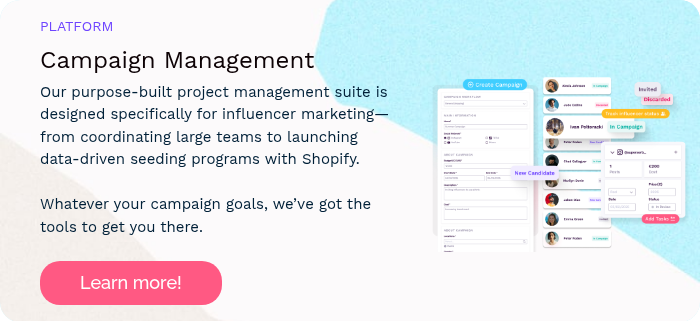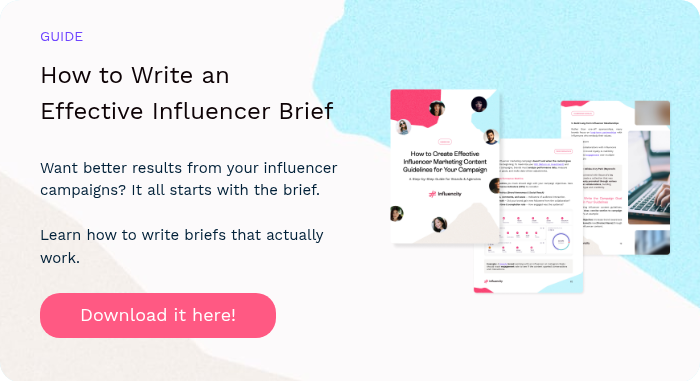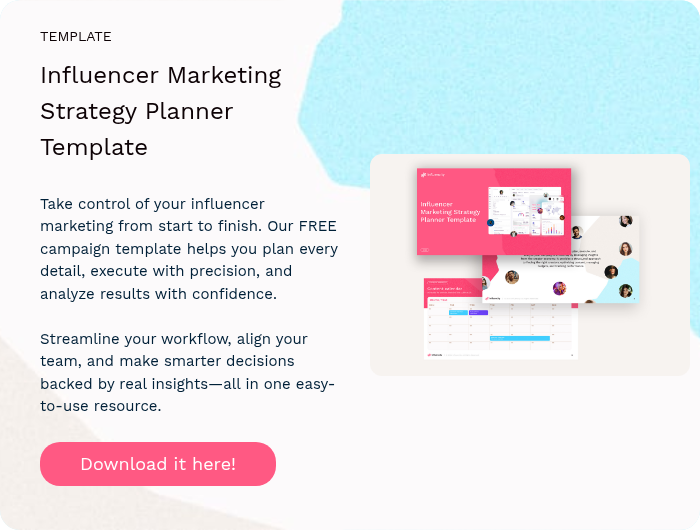42 min read
August 5, 2025
Aug 5, 2025
Best Advertising Campaigns Powered by Influencer Partnerships
Written by: Jackie Zote
A few months ago, I was pleasantly surprised to see that a Taiwanese band I’ve been following for a few years landed a partnership with Uniqlo. The brand wrote a theme song that fit perfectly with their music and the brand’s comfortable clothing – soothing but funky.
This collaboration made perfect sense with the band’s fanbase being the type of people who’d want to wear Uniqlo – young adults who are into urban yet relaxed fashion. And Uniqlo seamlessly infused the band into the campaign by leveraging them as co-creators who helped to push their core brand message instead of having them as “add-ons.”
Similarly, there are several advertising campaigns that boast a flawless influencer integration. In this post, I’ll be breaking down these campaigns and dissecting what sets them apart. So you can infuse those elements into your own influencer advertising campaigns. Let’s take a look.
What Sets These Campaigns Apart?
Before getting into the ad campaigns, let’s first take a closer look at what sets them apart. Many brands have worked with influencers for their advertising campaigns, so what makes these ones different?
For most campaigns that involve influencer partnerships, influencers are featured as add-ons to the campaign. They become the face of the campaign or help to maximize the campaign’s reach. But beyond that, they have no other involvement in the campaign. Think of them as models recruited to represent the brand for a specific ad campaign.
But the campaigns that we’ll be discussing in this article go way beyond simply featuring influencers. Instead, influencers are deeply infused into the campaign framework. Instead of simply being the “face” of the campaign, influencers serve as co-creators and strategy partners.
Integration of Influencer Storytelling into Paid Creative
The featured campaigns involve influencers helping to share the brand’s core message through impactful storytelling. Instead of simply regurgitating a brand-written message, influencers tell their unique story in an authentic voice that resonates with the target audience.
While some influencers share their lived experience to relate to the audience, others use their unique voice to lend authenticity to the campaign. This storytelling is then integrated into the campaign’s paid creative to generate a bigger impact.
Strategic Use of Influencer Insights to Inform Decisions
Another aspect of these advertising campaigns is the way they leverage influencers during the campaign planning stage. Instead of using guesswork to make decisions and expecting influencers to adapt to those decisions, they make the most of influencer insights to make strategic decisions.
This is particularly apparent when it comes to ad formats. Brands use influencer data to identify the content formats that audiences find most engaging. They then rely on these formats to deliver the message.
Similarly, they also look into the influencer’s audience data to inform their targeting. This results in campaigns that effectively reach and resonate with the right audience.
Top Influencer-Led Advertising Campaign Breakdowns
Now let’s get to the juicy part. Below, I break down some of the top advertising campaigns that feature influencers at the core.
Nike’s “Dream Crazier” Campaign with Serena Williams
Starting with the campaign that gave me goosebumps, Nike’s “Dream Crazier” campaign blends powerful brand storytelling with elite athlete influence. The campaign video shines a spotlight on a series of leading female athletes who have broken barriers and inspired generations of athletes.
This includes athletes like Chloe Kim, Simone Biles, and the U.S. Women’s National Soccer Team – many of whom have been subject to unreasonable criticism.
The voiceover features a narration by Serena Williams, highlighting the stories and experiences that are all too familiar for these female athletes, with an inspirational background music for greater emotional impact. She explains how female athletes are held to unrealistic standards, facing criticism for the smallest things, and their challenges minimized.
The video concludes with a message: “So if they want to call you crazy? Fine. Show them what crazy can do.”
As a brand that strives to “bring inspiration and innovation to every athlete in the world,” this inspirational campaign helped Nike to effectively showcase their core message. With an elite athlete like Serena amplifying the message with her own story and voice, Nike took the campaign to another level.
Fenty Beauty with Diverse Influencers
When it comes to diversity and inclusion, no one does it better than Fenty Beauty. From the brand’s inception, the goal was to develop inclusive beauty products that fit all shades and colors. So their marketing campaigns also rely on crowd-sourced content from the beauty community, showcasing a diverse set of creators with varying skin tones, colors, and types.
For this example, we won’t be singling out any specific campaign as the brand runs an always-on influencer campaign to crowd-source content for social media.
Fenty Beauty leverages authentic product trial content from beauty influencers as a part of their organic Instagram marketing campaign. These creators demonstrate the brand’s products in action without any filters or retouching, showing real skin with all the lines and texture. This helps to boost trust and credibility while effectively highlighting the product’s true capability.
Moreover, the content comes from influencers with various skin colors and tones. This helps the brand cater to a diverse audience, staying true to their goal of inclusivity.
Heinz x Ed Sheeran
The Heinz partnership with Ed Sheeran has to be one of the most ingenious advertising campaigns of the recent decade. And there are a few reasons why it worked – authenticity, humor, and star influence all blended to create a viral campaign that would go down in the marketing history books.
It all started with the singer sharing his love for the brand’s ketchup in an Instagram post with a caption inviting them to “slide into his DMs” to hear all about his idea for a TV ad. The publicity from this post alone had already set up this campaign for success. The brand quickly followed up because why waste an opportunity to leverage a celebrity’s genuine love for your product?
This is the biggest reason why the campaign worked so well, especially with the singer’s Heinz ketchup tattoo further solidifying his passion for the brand. There was a true sense of authenticity in the partnership, which fueled the campaign’s success.
Just a few months later, Heinz brought Ed Sheeran’s idea to life in a video ad that creatively showcased the singer’s sense of humor and relatability. Needless to say, it was a huge hit with audiences. The YouTube video alone has garnered over 10 million views on the brand’s channel.
Further riding on the singer’s genuine love for Heinz, the brand extended the campaign with limited-edition “Edchup” bottles inspired by Ed Sheeran’s tattoo. Some of these bottles were given to superfans, while the rest were auctioned off for charity, bringing further publicity to the campaign.
How to Build These Elements into Your Own Work
There are a few key elements that the above campaigns have in common. Building these elements into your own influencer advertising campaigns can set you up for success.
Briefing Influencers Like Creative Partners, Not Ad Units
For your campaign to work, it’s important to avoid treating influencers as ad units that are separate from the brand. Instead, they should be treated as an extension of the brand so they’re seamlessly integrated into the campaign. This means briefing them like creative partners.
Involve them in the ideation and creative process to take advantage of their original and unique voice. In many cases, influencers are creatives – whether they create social media content or produce art. Meanwhile, other types of influencers will also be able to share their unique takes based on their experiences in their respective industries.
So they serve as an excellent source of inspiration for original and refreshing content ideas that will resonate with the audience. For the Ed Sheeran partnership, Heinz relied on the singer’s advertising idea to come up with something brilliant instead of simply featuring him in the ad.
Meanwhile, the Nike ad made use of Serena Williams’s lived experience and the experiences of many other female athletes to come up with something impactful and inspiring. That’s the difference that you can make when influencers are infused into the campaign as creative partners.
Re-Using Influencer UGC in Paid Social, TV, and Out-of-Home
Along the same lines, the creativity and authentic voice of influencers tend to have a strong impact on audiences. So the content they create for you can be highly effective for building trust. That’s why you should consider reusing or repurposing it as ad content across different channels, including paid social, TV, and out-of-home advertising.
From honest reviews and product demos, reusing UGC from influencers as paid ads can help you boost trust, especially with the credibility they have with the right audience.
@thelamialens 🎀 ORGANIC UGC EXAMPLE Love creating this type of ASMR videos ✨ 📢 BRANDS! Looking for UGC for your brand? I have created content for over 60 brands in different niches including skincare and beauty. 💖 💌 Drop me an inquiry at contact@lamiaugc.com #ugc #ugccreator #usergeneratedcontent #contentcreator #ugccreatoruae #ugccreatordubai #ugcdubai ♬ Woman (Instrumental) - Luke Muzzic
In the Heinz example, the brand made the most of Ed Sheeran’s organic content, with the caption serving as the script for the ad. This lends authenticity to the ad and further adds an element of humor to the whole campaign.
Budgeting for Influencer Licensing Across Ad Channels
Keep in mind, however, that reusing influencer content for your paid advertising will require appropriate licensing and permissions. Make sure you set aside a budget to pay for the necessary licensing to reuse influencer-generated content across your ad channels.
Have a clear idea of the ad channels you’ll be using so you can plan your contracts and licensing fees accordingly. So you can strategically allocate your influencer marketing budget and prevent unexpected costs later on. Maintain clarity with influencers about where and how you’ll be using their content. This will minimize the risk of any dispute or legal conflicts further down the line.
Replicable Takeaways for Brands
With all the above factors considered, you may now be ready to plan your influencer advertising campaign. To help make the process easier, here are a couple of handy replicable takeaways you can reuse for your work.
Influencer-First Creative Briefing Template
Customize this creative briefing template to build an influencer-first advertising campaign.
- Campaign Goal: To drive excitement for the launch of our new collection and promote user-generated content.
- Deliverables: 1 Instagram post, 2 Reels, 2 TikTok videos.
- Deadlines: Submit all draft content on the platform by August 15 for review. Finalized teaser Reel and TikTok video to go live by August 20. Finalized Instagram announcement post, follow-up Reel, and follow-up TikTok video to go live by August 22.
- Brand Tone: Playful yet positive and inspiring.
- Creative Direction: Emphasize the product’s effectiveness through demos and before-and-after footage.
- Platform-Specific Tips:
- TikTok: Unboxing and before-and-after footage with expressive audio
- Instagram: Helpful demo videos and grid-worthy flat lays
- Influencer Prompt: Share honest reactions and experiences. Don’t be afraid to mention flaws/areas for improvement.
- Hashtags/Mentions/Disclosures: Tag @BrandName, use #BrandName and #CollectionName, disclose partnership with Paid Partnership label.
- Additional Content Guidelines: Avoid explicit mentions of competitor brands.
You can also download our step-by-step guide on how to write an effective influencer brief.
Sample Influencer-to-Paid Workflow Checklist
Building a paid advertising campaign from your influencer marketing campaign involves a lot of moving parts. Here’s a useful checklist to ensure you get the workflow right:
- Define your campaign goals.
- Understand which audiences you’re targeting.
- Lay out your influencer marketing channels.
- Have a clear idea of your paid advertising channels.
- Decide on the content formats for both organic and paid channels.
- Set a realistic budget and allocate it.
- Identify your ideal influencers.
- Reach out to influencers and negotiate.
- Finalize contracts and payments.
- Develop your content strategy (and involve influencers as needed).
- Launch your influencer campaign.
- Track campaign performance and focus on influencer-specific and content-specific insights.
- Identify your top-performing influencers and posts.
- Repurpose high-performing influencer content across relevant paid channels.
- Measure success and leverage the data to adjust your campaign as needed.
Take Your Influencer Advertising Campaigns to the Next Level
The most successful influencer advertising campaigns infuse influencers into the campaign framework. Rather than treating them as an ad unit, influencers are recruited as creative partners, often bringing fresh ideas and unique voices to guide campaign direction. Make the most of the examples and takeaways I highlighted above to enrich your own influencer ad campaigns.
Other posts you might be interested in
View All Posts
Social Media
32 min read
| September 3, 2025
Fake Engagement vs. Real Influence: How to Spot the Difference in 2025
Read More
Influencer Marketing
50 min read
| September 2, 2025
Affiliate Marketing Tactics That Actually Work for Brands & Influencers
Read More
Influencer Marketing
41 min read
| September 1, 2025




